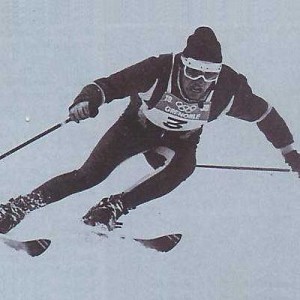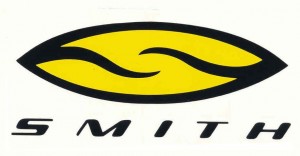
Jean Claude Killy with old style goggles
I used to hate skiing when it was snowing. During the 1950s and 1960s I would dread those snowy days even though I knew they usually meant good skiing conditions. Starting in about 1970 I began to actually enjoy those snowy days and now they are my favorite days of the season! What made the difference? In two words: better goggles!
With the old goggles you were in for a day-long struggle when it snowed. Usually your first run was fine, but by the second run the goggles would start to fog or ice up. But you could still see, sort of. By the third run you had some decisions to make: go into the lodge, try to de-fog outside, or tough it out. You chose de-fog outside? Too bad. Oh, you could wipe off the lens with something, but the minute you took your goggles off you began a losing cycle. In other words you may have won the battle but lost the war.
So somewhere on that next run things would get worse. You’d have to stop and de-fog again or fly blind. So the run became ski, stop, de-fog, repeat!
The best original choice would have been to go in the lodge and completely dry and de-fog your goggles. Of course I never made that choice until I had no other choice.
The above scenario assumed that you hadn’t fallen at any point. With the old style goggles, any decent fall meant your goggles came off and landed in the snow. And the de-fog cycle would begin at that point.
I also mentioned flying blind and there actually was a slight variation on this. You could get so frustrated that you just popped the goggles up onto your hat and skied without them. This actually hurt if it was snowing hard. Even today when I see somebody without goggles or glasses skiing in a snowstorm I wince.
Of course you always got plenty of advice on how to solve the fogging problem. You could pop the bottom of the lens out of the frame to increase ventilation; you could use liquid dish soap to coat the lens; you could spit on them; or you could try Cat Crap (it’s a real product). None of these were long term solutions.

Smith Logo Today
I wasn’t the only one who was frustrated by the goggles available in that era. Robert Smith was a dentist and a serious skier. In fact it was said that he was a dentist in the summer and a skier in the winter! He appeared in a Jackson Hole powder sequence of Dick Barrymore’s movie “The Last of the Ski Bums” in 1967 wearing the ugliest pair of goggles you’ve ever seen. But he was onto something.
Robert Smith was driven to design a ski goggle that would resist fogging. He developed and patented the key concepts present in today’s ski goggles. First is the dual pane lens. The lens is actually two lenses with a sealed air space between them. Second, the use of a breathable foam around the frame of the goggles that allows air in-and-out, but keeps snow and water out.
There was a third important factor used by Smith which was a strong, wide elastic strap. When I first got my Smiths, I remember doing a front somersault in two feet of heavy powder at Sun Valley. I came up with my goggles still on, they weren’t fogged, and I kept going!
Robert Smith started the Smith Optics Company which continues today selling a complete line of goggles and sunglasses.
Kim Brown of the Ski Bum Corner correctly identified Smith as the answer to last week’s trivia question. He also pointed out that Smith invented a battery operated fan system for goggles which is still available in top of the line Smith goggles.
I know there are some people reading this article who are saying “my goggles still fog!” The best advice I can give with modern ski goggles is to keep them dry and keep them on. Only use anti-fog cloths if your goggle maker says you can – many expressly say not to use them.

January 19, 2012 at 11:47 pm
I think the first shaped ski was made by Elan. I remember how odd they seemed at the time.
My most memorable ski was the Kastle Freestyle Pro. They were twin-tipped, and in the early and mid-70’s when freestyle skiing began, they were a whole lot of fun.
September 16, 2012 at 6:56 am
i bought my kastle freestyle pro’s in high school, 1980. 170cm, black as night with one of the first twin tips ever. What a GREAT ski. I had so much fun bashing moguls, skiing the woods and having a ball doing things the other skis of the time just would not do. I wish is still had my pair.